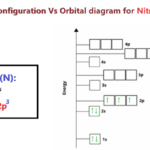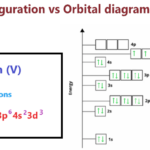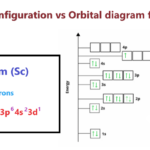Orbital diagrams, How to draw with examples + rules?
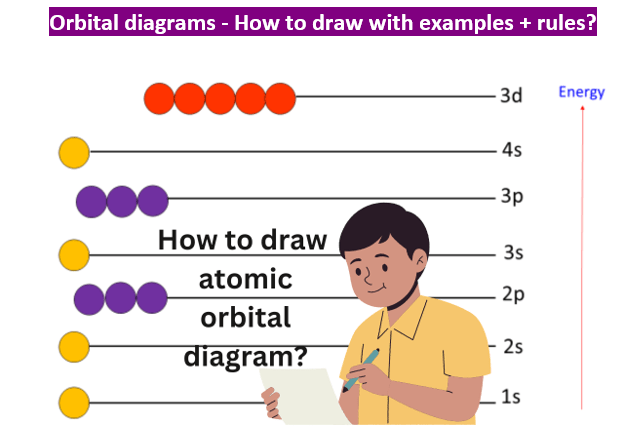
All of us chemistry enthusiasts know that electrons revolve around the positively charged nucleus of an atom in specific energy levels. These energy levels are known as shells. But do you know that these shells are further divided into subshells, each with a specific number of atomic orbitals?
In this article, we will discuss all the different rules and principles of filling electrons in an atomic orbital diagram, followed by plenty of examples for drawing an orbital diagram or orbital notation configuration.
What is an Orbital diagram?
An atomic orbital is a three-dimensional description of the location of an electron around the nucleus of an atom. In other words, there is a maximum probability of finding an electron in an atomic orbital.
There are 4 main types of subshells, namely s, p, d, and f. Each subshell is divided into a specific number of orbitals. The atomic orbitals lying in the same subshell are degenerate, i.e., situated at an equal energy level. However, the energy of the atomic orbitals belonging to different subshells varies significantly.
“We use orbital diagrams as a pictorial representation of the electrons present in an atom’’.
The s-subshell has only a single spherical-shaped atomic orbital. The p -subshell has 3 dumbbell-shaped degenerate atomic orbitals known as px, py, and pz. In contrast, the d and f-subshells are comprised of 5 and 7 degenerate atomic orbitals, respectively.
The electrons are not randomly filled in the different atomic orbitals of an atom. Rather, special rules are followed for assigning the location of an electron in an atomic orbital.

How to Draw Orbital Diagrams - rules?
The orbital diagram or orbital notation simply represents the arrangement of electrons in different orbitals of an atom. In an orbital diagram, an electron is represented by an arrow, while a box represents an atomic orbital.
There are three different rules used for constructing an atomic orbital diagram. These include – i) the Aufbau principle, ii) Hund’s rule, and iii) the Pauli exclusion principle.
(1). Aufbau’s principle:- The Aufbau principle states that electrons occupy atomic orbitals in an ascending energy order. The lower energy orbital is filled first, followed by a higher energy orbital. For example, the electrons present in an atom first occupy 1s atomic orbital, then 2s, then 2p, and so on and so forth.

(2). Hund’s rule:- As per Hund’s rule, the degenerate atomic orbitals are first singly filled and then pairing occurs. For example, one electron is placed in each of the three p atomic orbitals, i.e., px, py, and pz, and then pairing occurs (as shown below).
A half-filled p-subshell is more stable than a partially-filled p-subshell. However, a completely filled p-subshell with a total of 6 electrons is the most stable.

(3). Pauli Exclusion Principle:- This rule states that no two electrons can occupy the same atomic orbital in the same spin. To minimize the same charge repulsion in an electron pair, one electron spins clockwise and the other anticlockwise.
To represent the anti-parallel spin states, an upwards (↑) and a downwards (↓) pointing arrow is used in the orbital diagram.

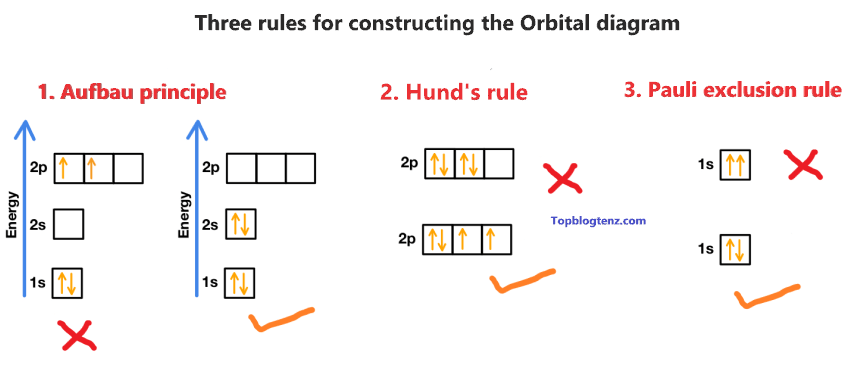
If you understand the above rules then constructing the orbital diagram or orbital notation for any atom is super easy.
Basics of Orbital diagram:-
There are different types of orbitals – s, p, d, and, f. These orbitals contain a number of boxes that can hold a number of electrons. Let’s see.
Each box will hold a maximum of 2 electrons with opposite spins.
- s orbital contains 1 box that can hold a maximum of 2 electrons.
- p orbital contains 3 boxes that can hold a maximum of 6 electrons.
- d orbital contains 5 boxes that can hold a maximum of 10 electrons.
- f orbital contains 7 boxes that can hold a maximum of 14 electrons.
The orbital diagram will be filled in the same order as described by the Aufbau principle.
“The Aufbau principle states that electrons will inhabit the lowest-energy orbitals first. This means that electrons can only enter higher-energy orbitals after lower-energy orbitals have been entirely filled.”
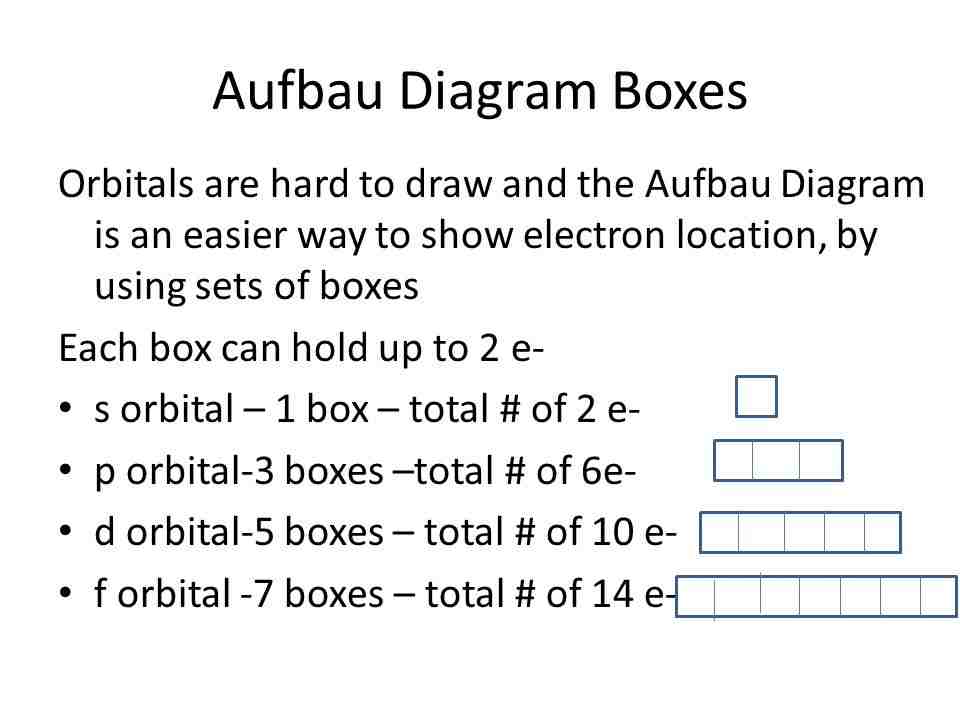
We have a diagonal rule for electron filling order in the different subshells using the Aufbau principle.

So, the order in which the orbitals are filled with electrons from lower energy to higher energy is –
1s < 2s < 2p < 3s < 3p < 4s < 3d < 4p < 5s < 4d < 5p < 6s < 4f < 5d < 6p < 7s < 5f < 6d < 7p and so on.
Trick:- you can learn the order of the orbital box diagram and then fill out the electrons in it.
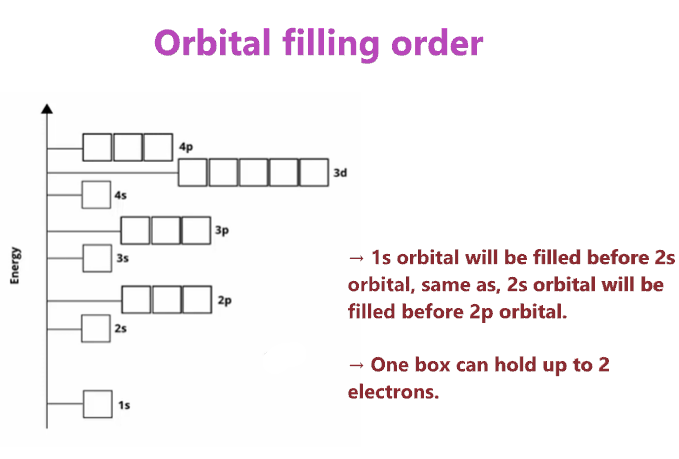
How to draw an Orbital diagram/notation?
To draw the orbital diagram for an atom, follow these basic steps.
- Find the number of electrons in an atom.
- Write the electron configuration for an atom to determine which orbitals should be filled.
- Fill the electrons in empty boxes using three principles – Aufbau, Hund’s, and Pauli’s Exclusion.
Let’s take an example of the Nitrogen atom to understand the concept of the making of filling the orbital diagram.
How to draw an Orbital diagram for Nitrogen?
We know that the nitrogen atom has a total of 7 electrons that need to be placed into orbitals, now for drawing its orbital diagram, we need to show its electrons in form of an arrow in different boxes using Aufbau, Hund’s, and Pauli’s exclusion rule.
- Nitrogen has a total of 7 electrons and its electron configuration is 1s22s22p3.
- As per the Aufbau rule, the electrons will be filled into 1s orbital first then 2s, then 2p…so on.
- 1s orbital contains 1 box, 2s orbital also contains 1 box and 2p orbital contains 3 boxes. Also, one box can hold up to two electrons.
- Therefore, the first two electrons of nitrogen will go in the 1s orbital, and the next two will go into the 2s orbital, now we are left with 3 electrons.
- These 3 electrons will go in the 2p orbital, since, the 2p orbital has 3 boxes, so, these electrons will be filled using Hund’s rule. (Each box gets one electron first).
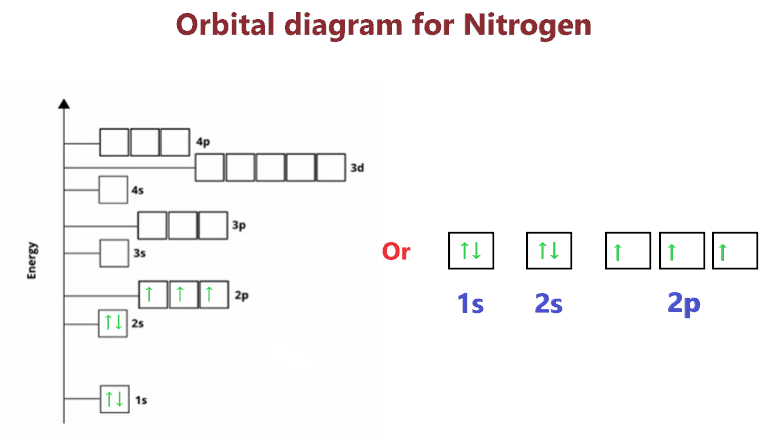
Also check – Orbital diagram calculator
Let’s take one more example to understand the procedure of drawing the orbital diagram for an atom.
How to draw an Orbital diagram for Potassium?
We know that potassium has a total of 19 electrons that need to be placed into orbitals, now for drawing its orbital diagram, we need to show its electrons in form of an arrow in different boxes using Aufbau, Hund’s, and Pauli’s exclusion rule.
- Potassium has a total of 19 electrons and its electron configuration is 1s22s22p63s23p64s1.
- As per the Aufbau rule, the electrons will be filled into 1s orbital first then 2s, then 2p…so on.
- 1s orbital contains 1 box, 2s orbital also contains 1 box, 2p orbital contains 3 boxes, 3s orbital contains 1 box, 3p orbital contains 3 boxes, and 4s orbital contains 1 box. Also, one box can hold up to two electrons.
- Therefore, the first two electrons of potassium will go into the 1s orbital, the next two will go into the 2s orbital, and after that, the next six electrons will go into the 2p orbital, since, the 2p orbital has 3 boxes.
- After that, the next two electrons will go into the 3s orbital, and the next six electrons will enter the 3p orbital. Now, the 3p orbital is full.
- Therefore, the remaining one electron will go in 4s orbital in the clockwise direction. (↑)

Take one more example of the atom – Chlorine (Atomic no. 17).
How to draw an Orbital diagram for Chlorine?
- Chlorine has a total of 17 electrons and its electron configuration is 1s22s22p63s23p5.
- As per the Aufbau rule, the electrons will be filled into 1s orbital first then 2s, then 2p…so on.
- 1s orbital contains 1 box, 2s orbital also contains 1 box, 2p orbital contains 3 boxes, 3s orbital contains 1 box and 3p orbital contains 3 boxes.
- Therefore, the first two electrons of chlorine will go into the 1s orbital, the next two will go into the 2s orbital, and after that, the next six electrons will go into the 2p orbital, since, the 2p orbital has 3 boxes.
- After that, the next two electrons will go into the 3s orbital, and the remaining five electrons will enter the 3p orbital, since, the 3p orbital has 3 boxes, so, these electrons will be filled using Hund’s rule. (Each box gets one electron first, then start pairing).

At last, Let’s try to construct one more atomic orbital diagram for the atom – Sodium (Atomic no. 11).
How to draw an Orbital diagram for Sodium?
- Sodium has a total of 11 electrons and its electron configuration is 1s22s22p63s1.
- As per the Aufbau rule, the electrons will be filled into 1s orbital first then 2s, then 2p…so on.
- 1s orbital contains 1 box, 2s orbital also contains 1 box, 2p orbital contains 3 boxes, and 3s orbital contains 1 box.
- Therefore, the first two electrons of the Sodium atom will go into the 1s orbital, the next two will go into the 2s orbital, and after that, the next six electrons will go into the 2p orbital, since, the 2p orbital has 3 boxes, so, these electrons will be filled using Hund’s rule. (Each box gets one electron first, then start pairing).
- After filling these orbitals, we are still left with 1 electron, this will go in 3s orbital.

| Atomic number | Name of the Elements | Orbital diagram |
| 1 | Hydrogen orbital diagram | Consists of one orbital – 1s. |
| 2 | Helium orbital diagram | Consists of one orbital – 1s. |
| 3 | Lithium orbital diagram | Consists of two orbitals – 1s and 2s. |
| 4 | Beryllium orbital diagram | Consists of two orbitals – 1s and 2s. |
| 5 | Boron orbital diagram | Consists of three orbitals – 1s, 2s, and, 2p |
| 6 | Carbon orbital diagram | Consists of three orbitals – 1s, 2s, and, 2p |
| 7 | Nitrogen orbital diagram | Consists of three orbitals – 1s, 2s, and, 2p |
| 8 | Oxygen orbital diagram | Consists of three orbitals – 1s, 2s, and, 2p |
| 9 | Fluorine orbital diagram | Consist of three orbitals – 1s, 2s, and, 2p |
| 10 | Neon orbital diagram | Consists of three orbitals – 1s, 2s, and, 2p |
| 11 | Sodium orbital diagram | Consists of four orbitals – 1s, 2s, 2p, and, 3s. |
| 12 | Magnesium orbital diagram | Consists of four orbitals – 1s, 2s, 2p, and, 3s. |
| 13 | Aluminum orbital diagram | Consists of five orbitals – 1s, 2s, 2p, 3s, and 3p. |
| 14 | Silicon orbital diagram | Consists of five orbitals – 1s, 2s, 2p, 3s, and 3p. |
| 15 | Phosphorus orbital diagram | Consists of five orbitals – 1s, 2s, 2p, 3s, and 3p. |
| 16 | Sulfur orbital diagram | Consists of five orbitals – 1s, 2s, 2p, 3s, and 3p. |
| 17 | Chlorine orbital diagram | Consists of five orbitals – 1s, 2s, 2p, 3s, and 3p. |
| 18 | Argon orbital diagram | Consists of five orbitals – 1s, 2s, 2p, 3s, and 3p. |
| 19 | Potassium orbital diagram | Consists of six orbitals – 1s, 2s, 2p, 3s, 3p, and 4s. |
| 20 | Calcium orbital diagram | Consists of six orbitals – 1s, 2s, 2p, 3s, 3p, and 4s. |
What is the difference between an Electron configuration or an Orbital diagram?
The main difference between the orbital diagram and electron configuration is an orbital diagram shows electrons in form of arrows whereas an electron configuration shows electrons in form of numbers. Also, the orbital diagram shows details on the spin of electrons whereas the electron configuration doesn’t show it.
Both these follow the Aufbau principle (Diagonal rule).
Take a look at the Electron configuration vs Orbital diagram for Nitrogen.

Please read out the articles on the Orbital diagram and electron configuration for various atoms to understand the concept better.
- Nitrogen orbital diagram and electron configuration
- Oxygen orbital diagram and electron configuration
- Carbon orbital diagram and electron configuration
- Fluorine orbital diagram and electron configuration
- Neon orbital diagram and electron configuration
- Boron orbital diagram and electron configuration
- Sodium orbital diagram and electron configuration
- Magnesium orbital diagram and electron configuration
- Aluminum orbital diagram and electron configuration
- Silicon orbital diagram and electron configuration
- Phosphorous orbital diagram and electron configuration
- Sulfur orbital diagram and electron configuration
- Chlorine orbital diagram and electron configuration
- Argon orbital diagram and electron configuration
- Potassium orbital diagram and electron configuration
- Calcium orbital diagram and electron configuration
- Beryllium orbital diagram and electron configuration
- Lithium orbital diagram and electron configuration
- Scandium orbital diagram and electron configuration
- Titanium orbital diagram and electron configuration
- Vanadium orbital diagram and electron configuration
Also Check:-
FAQ
What is an orbital diagram? |
| An atomic orbital is a three-dimensional region around the nucleus of an atom in which the probability of finding an electron is maximum. So an orbital diagram is a pictorial representation of the electrons present in the different orbitals of an atom. |
What are the three rules for drawing an orbital diagram? |
|
The 3 rules for drawing orbital diagrams are – the Aufbau Principle rule, the Pauli-Exclusion Principle, and Hund’s rule.
|
How do you write orbital diagrams?We can write an orbital diagram for any atom by following three basic steps-
|
What do the arrows and the boxes represent in an orbital diagram? |
↑↓ represents the electrons present in an orbital that are spinning in opposite directions, i.e., spin-paired electrons. |
How many different types of atomic orbitals are shown in an orbital diagram?A shell consists of subshells, and each subshell of an atom is composed of a definite number of atomic orbitals. In an orbital diagram;
|
How electrons of an atom are represented in an orbital diagram?
In the same energy orbitals, such as 2p, one upwards-pointing arrow is drawn in each box, followed by its pairing with a downwards-pointing arrow, until all the electrons initially available are consumed. |
How unpaired electrons are represented in the Orbital box diagram?When the orbital box contains only one electron, it is said to be an unpaired electron box. The unpaired electron is always represented with spin-up arrows (↑), it doesn’t contain a spin-down arrow(↓). |
What is the order of filling electrons in the Orbital boxes diagram?The orbital diagram will be filled in the same order as described by the Aufbau principle. The order in which the orbitals are filled with electrons from lower energy to higher energy is –
The above order means –
|
What is the difference between an orbital diagram and an electronic configuration? |
|
The orbital diagram and the electronic configuration are both ways of representing the total number of electrons present in an atom. The difference between the two is that arrows are used for representing electrons in an orbital diagram, while numerical values are used while writing the electronic configuration of an atom. Additionally, the orbital diagram shows the spin of electrons in an orbital, while the electronic configuration does not. For instance, the electronic configuration of oxygen is written as 1s2 2s2 2p4, while its orbital diagram is shown below.
|
How do you write the electronic configuration of magnesium (Mg), and how can you construct its orbital diagram? |
|
The atomic number of magnesium is 12 so there are a total of 12 electrons in a neutral Mg atom. The electronic configuration of magnesium (Mg) is written as 1s2 2s2 2p6 3s2. The atomic orbital diagram for Mg atom is shown below.
|
Explain with the help of the orbital diagrams, why the 2p-subshell of nitrogen is more stable than that of oxygen. |
|
The electronic configuration of nitrogen (N) is 1s2 2s2 2p3. The orbital diagram drawn for nitrogen shows that the 2p subshell is singly filled. Each of the three p-orbitals contains a single unpaired electron only. The electronic configuration of oxygen is 1s2 2s2 2p4. The orbital diagram for oxygen illustrates a partially-filled 2p-subshell. One of the three 2p orbitals of oxygen contains paired electrons. A half-filled 2p subshell is more stable than a partially-filled 2p subshell. So it is due to an extra electron in oxygen that it is less stable and thus more reactive than nitrogen.
|
How can you compare the stability of fluorine with that of neon using orbital diagrams? |
|
The electronic configuration of fluorine (F) is 1s2 2s2 2p5. Its atomic orbital diagram shows that it has a single unpaired electron in the 2p-subshell. Therefore, it is highly reactive and thus unstable. An F-atom is the most electronegative atom in the Periodic Table. It readily gains one electron to completely fill its 2p orbitals. The electronic configuration of neon (Ne) is 1s2 2s2 2p6. A completely filled 2p-subshell in the orbital diagram of neon (as shown below) accounts for its extraordinary stability. Hence Ne is an inert, noble gas.
|
What is the difference between an atomic orbital diagram and a molecular orbital diagram? |
|
Atomic orbitals are associated with a particular atom, while molecular orbitals belong to the entire molecule. Atomic orbitals combine to form molecular orbitals after chemical bonding. So an atomic orbital diagram shows the arrangement of all the electrons present in a single atom of an element. However, the molecular orbital diagram is characteristic of the distribution of all the electrons present in molecular orbitals after bond formation. The atomic orbital diagram of a neutral oxygen (O) atom, is shown below.
The molecular orbital diagram for an oxygen (O2) molecule is shown below-
|
Summary
- An orbital diagram, or orbital filling diagram, is a type of notation that illustrates an atom’s electron distribution and electron spin within orbitals.
- The orbital diagram is drawn by using three rules – Aufbau’s rule, Hund’s rule, and Pauli’s exclusion rule.
- For drawing the orbital diagram or orbital notation, first, find the number of electrons in an atom then write its electron configuration to determine which orbital should be filled.
- And then fill the electrons in empty orbital boxes using three rules.
- The electron is always filled in an orbital box starting with a spin-up arrow(↑).
- Orbital configuration represents electrons in form of the arrow(↑↓) and Electron configuration represents electrons in form of numbers.
- One box of orbital diagrams can hold up to 2 electrons.
- Both the Orbital configuration and Electron configuration follow the Aufbau principle. That means the lower energy orbital will be filled first(i.e. 1s orbital is filled before the 2s orbital).
About the author
Vishal Goyal is the founder of Topblogtenz, a comprehensive resource for students seeking guidance and support in their chemistry studies. He holds a degree in B.Tech (Chemical Engineering) and has four years of experience as a chemistry tutor. The team at Topblogtenz includes experts like experienced researchers, professors, and educators, with the goal of making complex subjects like chemistry accessible and understandable for all. A passion for sharing knowledge and a love for chemistry and science drives the team behind the website. Let's connect through LinkedIn: https://www.linkedin.com/in/vishal-goyal-2926a122b/







